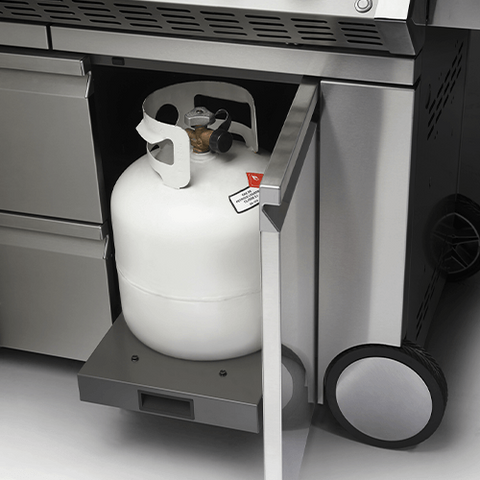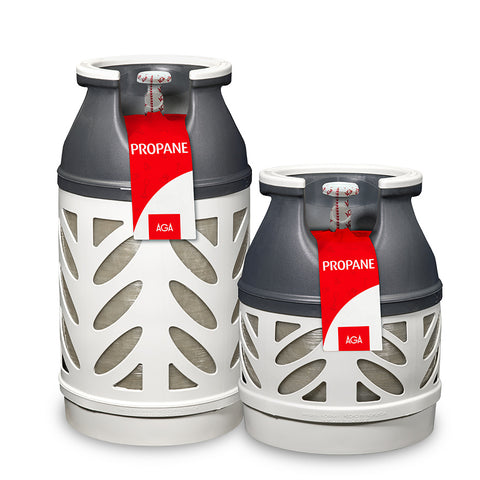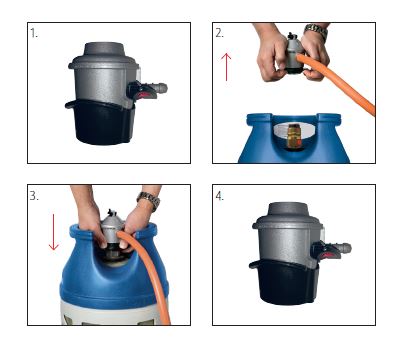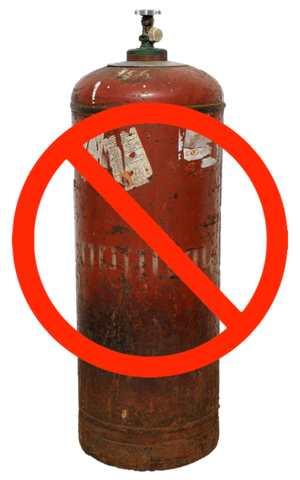While gas grills are still in their infancy in Lithuania, they account for the largest share of all barbecues sold worldwide. We still have a lot of opinions, but not facts, as to why food cooked on a gas grill is inferior to food cooked on a charcoal (and especially a kamado) grill.
This time we will not expand on this much-debated topic, but will leave it for our other posts. However, we would like to take a moment to recall the advantages of gas grills, such as the ability to quickly and and very easy to control, even combustion, large grill area, low fuel consumption, legal grilling on balconies and terraces, safety, etc.

If you have already decided that a gas barbecue is the best choice for your needs and situation, we invite you to read the information on choosing a fuel and gas cylinder.
Composition of gas
Natural gas is extracted from deep within the earth. It is made up of mixtures of gases with different chemical compositions and different physical properties. They usually contain methane (the base), ethane, propane, butane, carbon dioxide and other gases in various proportions. The gases used in industry and in our homes, where stoves are connected to a centralised city or town gas supply, are mainly methane.
Because methane gives off relatively little heat, gas grill manufacturers around the world suggest using other gases such as propane, butane or a mixture of the 2. The same amount of propane/butane burns produces 2.5 times more heat compared to methane-based gases.
So if your grill is not hot enough, or if you can't cook a juicy steak at home with a gas stove (it needs a high temperature), the answer lies in the gas type. All you have to do is change from methane to propane/butane gas.
Propane or butane?
Obviously, the heat generated has narrowed the choice down to propane and butane gas or a mixture of the two. Butane gas is slightly cheaper than propane gas, and there are many more outlets for bottles filled with this gas. But cheaper is not always better.

In summer you can choose any type of gas, but as the weather gets colder, be aware that butane gas turns into a liquid at temperatures as low as minus 2C, while propane only turns into a liquid at -42C. Once the gas has turned to liquid you simply cannot produce combustion and heat. So at lower temperatures and in winter, choose only propane gas.
If you have a mixture of propane and butane in your cylinder, you simply won't have as much pressure in the winter and you won't be able to fully burn the gas in the cylinder. So be careful - even though it may look like there is still gas in the cylinder, it could just be butane in liquid form.
Although it is sometimes said that food tastes different when cooked with different gases, we leave it up to you.
Gas cylinders made abroad are often different colours: butane cylinders are blue, while propane cylinders are red.
What size cylinder should I choose?
First of all, this is determined by your barbecue itself: if your barbecue trolley has a safe place at the bottom (in the cabinet), it would be quite stupid not to use it. Especially as aesthetics are still important for many grillers. And balloons are not usually the most decorative part of a patio or terrace. So if you are going to keep the balloon in a cabinet, check the grill manufacturer's instructions or the information on the grill cabinet to see what capacity/height of balloon you can put in. If there is no such information, you will have to measure. Choose the maximum size you can fit.

In any case, whether you store the cylinder in the cabinet or next to the grill, in an open area, we recommend having 2 cylinders: one shall be used and connected to the barbecue, while the other shall be a substitute. After all, you don't want to run out of gas right in the middle of the party - which, as if on purpose, happens at the most inopportune moment...
What is the cylinder made of?
In the next 3 years, the Lithuanian government plans to ban the use of old cylinders made in the Soviet Union, in line with EU law. The argument is that they are safe. Such cylinders simply won't fill up at a petrol station. So if you are planning to buy a gas cylinder, think about whether it is worth saving money here.
Commonly used gas cylinders - Metal. They are extremely heavy and cause a lot of inconvenience when they have to be repositioned or refilled. One of the solutions we recommend is Composite cylinders.

Composite gas cylinders (manufactured by Linde)
JTheir advantages are numerous:
- You can keep track of the amount of gas left, so it doesn't run out unexpectedly: there is a special transparent space on the side of the cylinder.
- Extremely light - 2 times lighter than steel cylinders of the same size.
- They are extremely durable: the composite material withstands well sunlight, UV radiation, temperature changes, chemicals and solvents.
- The balloon does not rust or scratch, and is easy to keep clean and recycle.
- The composite balloon will not explode when exposed to fire. When the material melts, the cylinder empties as the gas escapes into the environment.
The composite cylinder is suitable for almost all propane applications at home, in summerhouses for barbecues, campers and boats. It is easy to use because it is easy to grip when lifting. The cylinder's use is further facilitated by the cylinder's pressure valve, to which a regulator can be easily connected ("Clip on system). You will no longer need strong hands or a special tool. This Clip on system is a great favourite amongst the fairer sex.
You can buy and fill these cylinders at Linde (formerly AGA) service stations and for more information see here
 Clip-on Composite Cylinder Connection System
Clip-on Composite Cylinder Connection System
Does your cylinder have a safety valve?
The old metal gas cylinders were not as safe as today's. For this reason, a new law has been introduced to regulate cylinder explantation, following EU recommendations.
As of 1 January 2020, it will no longer allow gas to be filled into metal cylinders that do not have a special safety valve. The cylinder itself does not need to be replaced for the time being. If the cylinder meets all the requirements, simply unscrew the old valve and replace it with a new type with a safety valve.

This valve is needed to ensure that in an emergency, in the event of a fire, and if the cylinder becomes very hot or pressurised, the accumulated gases can be removed through the valve, rather than the cylinder itself exploding and damaging property. When the barbecue is outdoors, such a gas leak simply dissipates into the air.
And if you want to know more about gas cylinders, their selection, connecting them to your grill or are considering the grill itself, we invite you to come and visit us at our newly refurbished showroom in Kaunas, Galindų str. 9. We have a huge variety of grills on display, for beginners and experienced amateurs, as well as for professionals.



